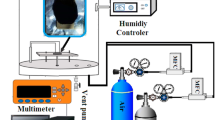Abstract
Hydrogen sensing property of composite films of camphorsulfonic acid-protonated polyaniline (Pani) with different amounts of multiwall carbon nanotube (MWCNT) was investigated in this paper. The MWCNT/Pani composite films were deposited by a spin-coating method on both ITO and Au-interdigitated electrodes (Au-IDE) substrates. Sensor film characteristics were evaluated by monitoring the change in electrical resistance in the presence of hydrogen at room temperature. It was observed that all MWCNT/Pani composite films showed the better sensor indicators such as sensitivity, response and recovery times in comparison with pure Pani. It was found that sensor indicators were improved by increasing the MWCNT filler concentration in composite. Moreover, it was observed that Au-IDE substrate drastically increased sensor sensitivity in comparison with uniform ITO-coated glass at 4 wt% MWCNTs exposed to 0.4 vol% H2 in the air.








Similar content being viewed by others
References
Kunzo P, Lobotka P, Micusik M, Kovacova E (2012) Palladium-free hydrogen sensor based on oxygen-plasma-treated polyaniline thin film. Sensors Actuators B Chem 171–172:838–845
Flandin L, Bidan G, Brechet Y, Cavaile JY (2000) New nanocomposite materials made of an insulating matrix and conducting fillers: processing and properties. Polym Compos 21:165
Roldughin VI, Vysotskii VV (2000) Percolation properties of metal-filled polymer films, structure and mechanisms of conductivity. Prog Org Coat 39:81
Li K, Diaz DC, He Y, Campbell JC, Tsai C (1994) Electroluminescence from porous silicon with conducting polymer film contacts. Appl Phys Lett 64:2394
Wang D, Qi S, Wu Y, An Q, Li C (2009) Synthesis and properties of polyaniline nanolayers in the presence of retinol in aqueous ethanol. J Appl Polym Sci 110:3162
Bafandeh N, Larijani MM, Shafiekhani A, Hantehzadeh MR, Sheikh N (2016) Synthesis of polyaniline films: case study on post gamma irradiation dose. J Mater Sci Mater Electron 27:10566–10572
Yellappa M, Shanthi Sravan J, Sarkar O, Rami Reddy YV, Venkata Mohan S (2019) Modified conductive polyaniline-carbon nanotube composite electrodes for bioelectricity generation and waste remediation. J Bioresour Technol 284:148–154
Haldar P, Biswas S, Sharma V, Chowdhury A, Chandra A (2019) Mn3O4-polyaniline-graphene as distinctive composite for use in high-performance supercapacitors. Appl Surf Sci 491:171–179
Seo C, Yoon Y, Kim D, Choi SY, Kim S (2018) Fabrication of polyaniline–carbon nano composite for application in sensitive flexible acid sensor. J Ind Eng Chem 64:97–101
Gu H, Wang Z, Hu Y (2012) Hydrogen gas sensors based on semiconductor oxide nanostructures. Sensors 12:5517–5550
Li Z, Yang M, Dai J, Wang G, Huang C, Tang J, Hu W, Song H, Huang P (2015) Optical fiber hydrogen sensor based on evaporated Pt/WO3 film. Sensors Actuators B Chem 206:564–569
Virji S, Kaner RB, Weiller BH (2006) Hydrogen sensors based on conductivity changes in polyaniline nanofibers. J Phys Chem B 110:22266–22270
Janata J, Josowicz M (2003) Conducting polymers in electronic chemical sensors. Nat Mater 2:19–24
Barkade SS, Naik JB, Sonawane SH (2011) Ultrasound assisted miniemulsion synthesis of polyaniline/Ag nanocomposite and its application for ethanol vapor sensing. Colloids Surf A Physicochem Eng Asp 378:94–98
Srivastava S, Kumar S, Vijay YK (2012) Preparation and characterization of tantalum/polyaniline composite based chemiresistor type sensor for hydrogen gas sensing application. Int J Hydrog Energy 37:3825–3832
Nasirian S, Moghaddam MH (2014) Hydrogen gas sensing based on polyaniline/anatase titania nanocomposite. Int J Hydrog Energy 39:630–642
Talwar V, Singh O, Singh RC (2014) ZnO assisted polyaniline nanofibers and its application as ammonia gas sensor. Sensors Actuators B Chem 191:276–282
Bafandeh N, Larijani MM, Shafiekhani A, Hantehzadeh MR, Sheikh N (2016) Effects of contents of multiwall carbon nanotubes in polyaniline films on optical and electrical properties of polyaniline. Chin Phys Lett 33:117801
Srivastava S, Sharma SS, Agrawal S, Kumar S, Singh M, Vijay YK (2010) Study of chemiresistor type CNT doped polyaniline gas sensor. Synth Met 160:529–534
Focke WW, Wnek GE (1988) Conduction mechanisms in polyaniline (emeraldine salt). J Electroanal Chem 256:343–352
MacDiarmid AG (2005) Conducting polymers as new materials for hydrogen storage. U.S. Department of Energy Presentation, Washington, DC
Srivastava S, Sharma SS, Kumar S, Agrawal S, Singh M, Vijay YK (2009) Characterization of gas sensing behavior of multi walled carbon nanotube polyaniline composite films. Int J Hydrog Energy 34:8444–8450
Xie XL, Mai YW, Zhou XP (2005) Dispersion and alignment of carbon nanotubes in polymer matrix: a review. Mater Sci Eng R 49:89–112
Gao ZY, Wang F, Chang JL, Wu DP, Wang XR, Wang X, Xu F, Gao SY, Jiang K (2014) Chemically grafted graphene–polyaniline composite for application in supercapacitor. Electrochim Acta 133:325–334
Chakraborty G, Ghatak S, Meikap AK, Woods T, Babu R, Blau WJ (2010) Characterization and electrical transport properties of polyaniline and multiwall carbon nanotube composites. J Polym Sci Part B Polym Phys 48:1767–1775
Sharma B, Yadav H, Kim J-S (2017) MEMS based hydrogen sensor with the highly porous Au-CNT film as a sensing material. J Mater Sci Mater Electron 28:13540–13547
Ramli MM, Isa SSM, Hambali NA, Isa MM, Kasjoo S, Nor N, Ahmad N, Khalid N, Murad S, Isa M (2016) Carbon nanotubes based hydrogen sensor on paper using Langmuir–Blodgett technique. In: 2016 3rd International conference on electronic design (ICED), vol 15. IEEE, p 387
Lee SP (2017) Electrodes for semiconductor gas sensors. Sensors 17:683
Author information
Authors and Affiliations
Corresponding author
Additional information
Publisher's Note
Springer Nature remains neutral with regard to jurisdictional claims in published maps and institutional affiliations.
Rights and permissions
About this article
Cite this article
Bafandeh, N., Larijani, M.M. & Shafiekhani, A. Investigation on hydrogen sensing property of MWCNT/Pani nanocomposite films. Polym. Bull. 77, 3697–3706 (2020). https://doi.org/10.1007/s00289-019-02915-8
Received:
Revised:
Accepted:
Published:
Issue Date:
DOI: https://doi.org/10.1007/s00289-019-02915-8




